Question
Which of the following combinations of person – city
– destination is correct? Study the below details and answer the following questions. Eight persons – A, B, C, D, E, F, G and H are going to four destinations viz., Delhi, Bangalore, Mumbai and Kolkata and they represent four different departments viz., Human Resources, Sales, Finance and Marketing but not necessarily in the same order. At least two persons belong to the same department and two of them visit the same destination. A belongs to the Finance department and he visits the same city as that of G. G doesn’t belong to the Finance, Marketing or Human Resources department. G doesn’t visit Kolkata or Mumbai. C visits Delhi and belongs to Human Resources department. The person who belongs to the Finance department other than A visits Delhi. B and G belongs to the same department. F visits Mumbai and he, doesn’t belongs to Sales and Marketing department. The two persons who belong to Marketing department visit Kolkata. D doesn’t belong to the Marketing department.Solution
A belongs to the Finance department and he visits the same city as that of G. G doesn’t visit Kolkata or Mumbai. So, he visits either Delhi or Bangalore. 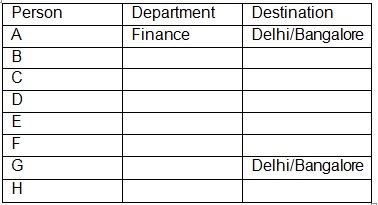 G doesn’t belong to the Finance, Marketing or Human Resources department. So, he belongs to Sales department.
G doesn’t belong to the Finance, Marketing or Human Resources department. So, he belongs to Sales department. 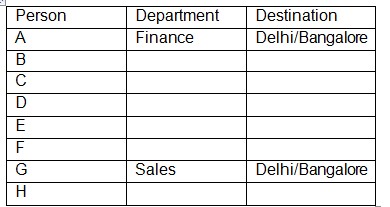 C visits Delhi and belongs to Human Resource department. Given, two persons visit same destination. So, A and G should travel to Bangalore.
C visits Delhi and belongs to Human Resource department. Given, two persons visit same destination. So, A and G should travel to Bangalore. 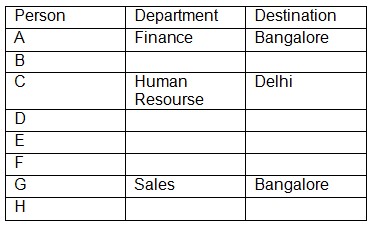 B and G belongs to the same department. So, B belongs to Sales department.
B and G belongs to the same department. So, B belongs to Sales department. 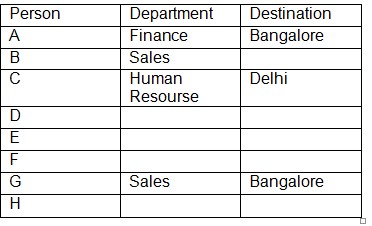 F visits Mumbai and he doesn’t belongs to Sales and Marketing department. So, he belongs to either Human Resources or Finance.
F visits Mumbai and he doesn’t belongs to Sales and Marketing department. So, he belongs to either Human Resources or Finance. 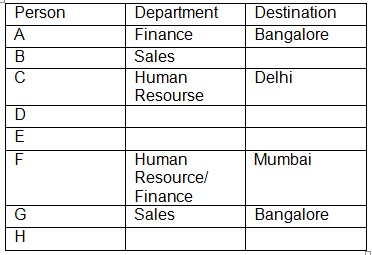 The two persons who belong to Marketing department visit Kolkata. D doesn’t belong to the Marketing department. Therefore, E and H belong to Marketing department and visit Kolkata.
The two persons who belong to Marketing department visit Kolkata. D doesn’t belong to the Marketing department. Therefore, E and H belong to Marketing department and visit Kolkata. 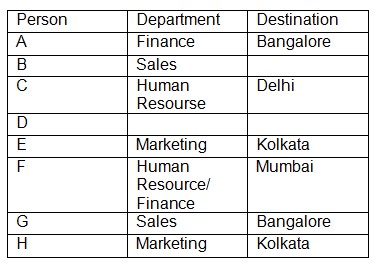 The person who belongs to the Finance department other than A visits Delhi. So, F belongs Human Resources. Therefore, D belongs to Finance and visits Delhi. B travel to Mumbai. The final arrangement will be as shown:
The person who belongs to the Finance department other than A visits Delhi. So, F belongs Human Resources. Therefore, D belongs to Finance and visits Delhi. B travel to Mumbai. The final arrangement will be as shown: 
Which of the following options correctly describes the sequence of formation of the following states in independent India in chronological order startin...
Match List-I with List-II and select the correct answer using the code given below the Lists.
Who wrote the famous Hindi novel 'Tamas"?
In QR code, What "R" means?
Aditi Ashok is associated with which sports?
12% of 3600 – 10% of 120
The first survey of Govishan city was done by which of the following Archaeologists?
Which two tech giants have partnered with ONDC to enhance its reach to small businesses?
Identify a class of compounds that has a functional group –OH.
Which of the following committees was/were set up by the government for local bodies in India?
1. Balwant Rai Mehta Committee
2. The Ashok...
Relevant for Exams:


